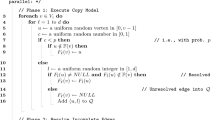Abstract
Random networks are widely used for modeling and analyzing complex processes. Many mathematical models have been proposed to capture diverse real-world networks. One of the most important aspects of these models is degree distribution. Chung–Lu (CL) model is a random network model, which can produce networks with any given arbitrary degree distribution. The complex systems we deal with nowadays are growing larger and more diverse than ever. Generating random networks with any given degree distribution consisting of billions of nodes and edges or more has become a necessity, which requires efficient and parallel algorithms. We present an MPI-based distributed memory parallel algorithm for generating massive random networks using CL model, which takes \(O\left( \frac{m+n}{P}+P\right) \) time with high probability and O(n) space per processor, where n, m, and P are the number of nodes, edges and processors, respectively. The time efficiency is achieved by using a novel load-balancing algorithm. Our algorithms scale very well to a large number of processors and can generate massive power–law networks with one billion nodes and 250 billion edges in one minute using 1024 processors.







Similar content being viewed by others
References
Barabási, A., Albert, R.: Emergence of scaling in random networks. Science 286, 509–512 (1999)
Barrett, C., Beckman, R., Khan, M., Kumar, V., Marathe, M., Stretz, P., Dutta, T., Lewis, B.: Generation and analysis of large synthetic social contact networks. In: Proc. of the Winter Sim. Conf., pp. 1003–1014 (2009)
Batagelj, V., Brandes, U.: Efficient generation of large random networks. Phys. Rev. E 71(3), 036113 (2005)
Carlson, J., Doyle, J.: Highly optimized tolerance: a mechanism for power laws in designed systems. Phys. Rev. E 60(2), 1412–1427 (1999)
Chakrabarti, D., Zhan, Y., Faloutsos, C.: R-MAT: A recursive model for graph mining. In: Fourth SIAM International Conference on Data Mining, vol. 4, 442–446 (2004)
Chassin, D., Posse, C.: Evaluating North American electric grid reliability using the Barabasi–Albert network model. Phys. A 335(2), 667–677 (2005)
Chung, F., Lu, L.: Connected components in random graphs with given expected degree sequences. Ann. Comb. 6(2), 125–145 (2002)
Erdös, P., Rényi, A.: On the evolution of random graphs. In: Publications of the Mathematical Institute of the Hungarian Academy of Sciences, vol. 5, pp. 17–61 (1960)
Girvan, M., Newman, M.: Community structure in social and biological networks. Proc. Natl. Acad. Sci. USA 99(12), 7821–7826 (2002)
Graph500: Graph 500. http://www.graph500.org/ (2010)
Latora, V., Marchiori, M.: Vulnerability and protection of infrastructure networks. Phys. Rev. E 71(1), 015103 (2005)
Leskovec, J.: Dynamics of Large Networks. Ph.D. thesis, Carnegie Mellon University (2008)
Leskovec, J., Chakrabarti, D., Kleinberg, J., Faloutsos, C., Ghahramani, Z.: Kronecker graphs: an approach to modeling networks. J. Mach. Learn. Res. 11, 985–1042 (2010)
Leskovec, J., Faloutsos, C.: Scalable modeling of real graphs using Kronecker multiplication. In: Proceedings of the 24th International Conference on Machine Learning, pp. 497–504 (2007)
Manne, F., Sorevik, T.: Optimal partitioning of sequences. J. Algorithms 19(2), 235–249 (1995)
Miller, J., Hagberg, A.: Efficient generation of networks with given expected degrees. In: Proceedings of Algorithms and Models for the Web-Graph, vol. 6732, pp. 115–126 (2011)
Olstad, B., Manne, F.: Efficient partitioning of sequences. IEEE Trans. Comput. 44(11), 1322–1326 (1995)
Pinar, A., Aykanat, C.: Fast optimal load balancing algorithms for 1D partitioning. J. Parallel Distrib. Comput. 64(8), 974–996 (2004)
Pinar, A., Seshadhri, C., Kolda, T.: The similarity between stochastic Kronecker and Chung-Lu graph models. In: Proceedings of the 12th International Conference of SDM, vol. 12, pp. 1071–1082 (2012)
Robins, G., Pattison, P., Kalish, Y., Lusher, D.: An introduction to exponential random graph (p*) models for social networks social networks. Soc. Netw. 29(2), 173–191 (2007)
Sanders, P., Träff, J.: Parallel prefix (scan) algorithms for MPI. In: Proceedings of the 13th Conference on Recent Advances in PVM and MPI, vol. 4192, pp. 49–57 (2006)
Siganos, G., Faloutsos, M., Faloutsos, P., Faloutsos, C.: Power laws and the AS-level internet topology. IEEE/ACM Trans. Netw. 11(4), 514–524 (2003)
Watts, D., Strogatz, S.: Collective dynamics of ‘small-world’ networks. Nature 393(6684), 409–410 (1998)
Yang, J., Leskovec, J.: Patterns of temporal variation in online media. In: Proceedings of the 4th ACM International Conference on Web Search and Data Mining, pp. 177–186 (2011)
Yang, J., Leskovec, J.: Defining and evaluating network communities based on ground-truth. In: Proceedings of the ACM SIGKDD Workshop, pp. 1–8 (2012)
Acknowledgments
This work has been partially supported by DTRA Grant HDTRA1-11-1-0016, DTRA CNIMS Contract HDTRA1-11-D-0016-0001, NSF NetSE Grant CNS-1011769, NSF SDCI Grant OCI-1032677, and NSF DIBBs Grant ACI-1443054.
Author information
Authors and Affiliations
Corresponding author
Rights and permissions
About this article
Cite this article
Alam, M., Khan, M. Parallel Algorithms for Generating Random Networks with Given Degree Sequences. Int J Parallel Prog 45, 109–127 (2017). https://doi.org/10.1007/s10766-015-0389-y
Received:
Accepted:
Published:
Issue Date:
DOI: https://doi.org/10.1007/s10766-015-0389-y




